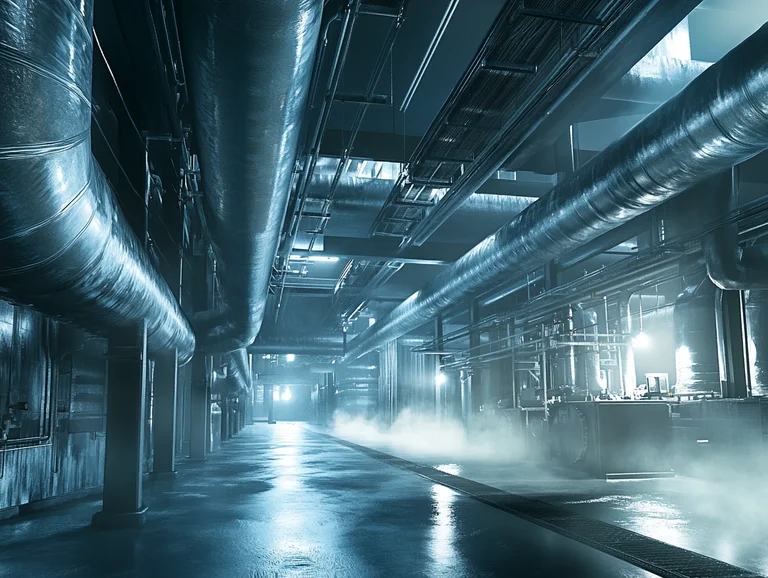- Basic Concepts
What Is Industrial Refrigeration?
What is industrial refrigeration, how does it work, and in which sectors is it used? Discover all the details of industrial refrigeration systems, the backbone of modern production from the food industry to pharmaceuticals, in this comprehensive guide.
Cooling Maestro
Co-Founder

As one of the unsung heroes of today’s modern production and industrial facilities, industrial refrigeration plays a vital role across a wide spectrum, from extending the shelf life of perishable products to ensuring the safety and efficiency of critical industrial processes. So, what exactly are these systems, which are far more powerful and complex than our household refrigerators, how do they work, and why are they so important?
In this article, we will explore in detail what industrial refrigeration is, its fundamental working principles, its main components, and the key sectors where it is utilized.
What Is Industrial Refrigeration?
Industrial refrigeration is the general term for cooling systems designed to maintain a specific volume at a desired low temperature in large-scale facilities, production lines, storage areas, or special processes. These systems, which typically focus on temperatures below 0°C (32°F), have much higher capacity, more complex structures, and more precise control mechanisms compared to commercial refrigeration systems (e.g., supermarket displays, restaurant refrigerators). The goal is not just to cool but also to stably maintain the set temperature.
What’s the Difference Between Industrial and Commercial Refrigeration?
- Capacity: Industrial systems are capable of cooling massive cold storage warehouses or entire production facilities.
- Temperature Range: They can often reach much lower temperatures (down to -60°C [-76°F] or lower).
- Refrigerants Used: Natural and highly efficient refrigerants like Ammonia (NH₃) and Carbon Dioxide (CO₂) are commonly used in industrial systems.
- Application: They are often used as an integral part of production processes (e.g., slowing down chemical reactions), whereas commercial systems typically focus on storing the final product.
How Do Industrial Refrigeration Systems Work?
Industrial refrigeration systems are primarily based on the vapor-compression refrigeration cycle. This cycle relies on the principle that a fluid (the refrigerant) absorbs heat from its surroundings as it changes phase (from liquid to gas and gas to liquid). The cycle consists of four main stages:
- Evaporation: The low-pressure liquid refrigerant absorbs heat from the space to be cooled (e.g., a cold storage room), causing it to evaporate and turn into a gas. This process cools the surrounding area.
- Compression: The gaseous refrigerant is drawn in by the compressor, which increases its pressure and temperature. This is the heart of the system.
- Condensation: The high-pressure, hot gaseous refrigerant is sent to the condenser unit. Here, it releases its heat to the outside environment (via air or water), condenses, and turns back into a liquid.
- Expansion (Expansion Valve): The high-pressure liquid refrigerant passes through an expansion valve, where its pressure is suddenly reduced. This process also causes a rapid drop in the refrigerant’s temperature, making it ready to re-enter the evaporator and start the cycle again.
Applications of Industrial Refrigeration
Industrial refrigeration is the cornerstone of many industries you can think of:
- Food and Beverage Industry: This is the largest area of use, for processing, freezing (blast freezing), and storing meat, dairy, fish, fruits, and vegetables. Cold storage warehouses are indispensable for this sector.
- Pharmaceutical and Chemical Industry: Maintaining specific temperature conditions is critical during the production and storage of medicines, vaccines, and chemical substances.
- Petrochemical Industry: Used for the liquefaction of gases (e.g., in LNG plants) and for controlling various chemical reactions.
- Data Centers: It removes the immense heat generated by constantly running servers, ensuring the equipment operates safely.
- Ice Rinks and Artificial Snow Production: The creation and maintenance of ice surfaces in entertainment and sports facilities are made possible by these systems.
- Concrete Cooling: Used especially in the construction of large dams and bridges to prevent the concrete from overheating and cracking as it sets.
Conclusion
Industrial refrigeration is one of the fundamental technologies that enables the functioning of the modern world. From ensuring our food reaches our tables fresh to guaranteeing the safety of the medicines we use, the footprint of these complex systems is everywhere. A well-designed, efficiently operated, and regularly maintained industrial refrigeration system is not just a necessity for businesses but also a significant investment that reduces energy costs and contributes to sustainability.
Let's Design the Perfect Solution for Your Project Together
Let us analyze your needs to design and implement a custom, energy-efficient, and durable refrigeration system for you. Contact us to meet our expert team and get a personalized quote for your project.
Customer Satisfaction
For us, success is more than just a delivered project; it's a long-term, trust-based partnership fortified by our after-sales support.
Field Experience
With over 15 years of industry experience, we craft the most precise and efficient solutions for every detail of your project.
Sustainability
Boost your business's profitability and competitive edge through our focus on Eco-Friendly and Energy-Efficient manufacturing.